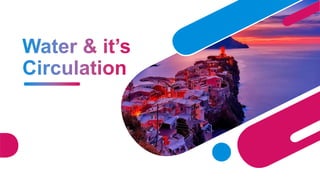
Water & it's circulation
- 2. 2 About 71% of the surface of the Earth is covered with water. No wonder then that our Earth is often referred to as a watery planet. All the water bodies such as oceans, seas, rivers, and lakes, etc; together make up the hydrosphere.
- 3. 3 The water cycle or the hydrological cycle is the continuous change of water from one physical state to another and its circulation from the surface of the Earth to the atmosphere and back.
- 4. 4 Ocean water evaporates due to Sun’s heat and reaches the atmosphere as water vapor. In the upper layers of air, cooling and condensation take place and the water vapor changes into water droplets. These grow in size and eventually fall down as precipitation. Some of the water falling on land, seeps down to Earth, while most of it flow into rivers which again join the oceans. Evaporation starts all over again and the cycle continues.
- 5. 5 water contains very little dissolved salt is called fresh water. Although ¾ of the Earth is covered by water, very little of it is fresh. 97% water on Earth are oceans and seas. This is saline water and is not suitable for human consumption. Rest 3% is fresh water, out of it 2% is in the form of ice caps and glaciers, which cannot be reached by us. Thus, only 1% of the earth’s fresh water is easily available and fit for hum to drink. It is found as waters in rivers & lakes as groundwater, water vapor in the atmosphere.
- 6. 6 Water containing a large amount of dissolved salt in it is called saline water. Example, the oceans and seas. Sodium chloride or common salt, magnesium chloride, magnesium sulphate and calcium sulphate are the main ones. The amount of salt in the ocean water is called salinity. The salinity of ocean water is on an average of 35 per thousand. This means that in 1000 grams of ocean water there are 35 grams of dissolved salts.
- 7. 7 1. Rate of evaporation 2. Amount of precipitation 3. Amount of fresh water that is added to the ocean.
- 8. 8 The temperature of ocean water is not the same everywhere and at all times of the year. Oceans are the warmest near the equator and becomes cooler towards the poles.
- 9. 9 • Oceans are the prime source of humidity and precipitation. • They moderate the climate of the coastal regions. • Marine life found in the ocean waters provides a source of livelihood to many people. • Salts dissolved in the ocean water and mineral deposits on the ocean floor are economically important to us. • Oceanic waves and tides can be harnessed to generate electricity. • Oceans serve as means of transport.
- 10. 10 The waters of the ocean are constantly in motion. They move horizontally as well as vertically. The movements of the ocean waters are of 2 types: waves and currents. • Differences in temperature • Differences in salinity • Prevailing winds • Variation in the density of sea water
- 11. 11 • Waves are the alternate up and down movement of the water particles caused by wind. • Particles of the water are pushed down by the wind and they come up again. • The upper part of the wave is called crest, the lower part is called trough. The vertical distance between the crest and trough is called wave height and the horizontal distance between 2 crests or 2 troughs is called wave length. • A light breeze produces gentle waves, while violent and stormy winds create huge waves which often cause widespread destruction.
- 12. 12 • The term tsunami comes from the Japanese word tsu meaning harbor and nami meaning wave. • Traditionally, tsunami is referred to as a huge tidal wave • They are caused by earthquakes, both on land and underwater, volcanic eruptions on the ocean floor and underwater explosions and landslides. • They cause massive destruction.
- 13. 13 • Tides are the periodic rise and fall of water level in the sea which occur at regular intervals, twice a day. • When the level of sea water rises, its high tide, when the level fall its low tide. • Tides are caused by the gravitational pull of the moon and sun. • The moon and sun, exert their combines gravitational pull in the same direction, resulting in extra high tides. These are known as spring tides. • They nullify each other’s gravitational pull resulting in a very low tides known as neap tides.
- 14. 14 • Ocean currents are streams of ocean water continuously flowing in a definite directions. • They are caused by the planetary winds on the surface of oceans and differences in temperature, salinity and density of waters. • Ocean current move clock-wise in the Northern Hemisphere, anti-clockwise in the Southern Hemisphere. • They move at speeds of 3 to 10 kmph. • Slow moving masses of water in the ocean are called drifts. • The ocean currents that flow from the equatorial region to the polar regions are warm currents, e.g, Gulf stream, North Atlantic Drift and kuro shio. • Ocean currents that flow from the polar region to the equatorial region are cold currents, e.g, Benguela current, Peru current and oya shio.
- 15. 15 Warm ocean currents raise the temperature of the coasts while cold ocean currents lower the temperature. Ocean currents influence navigation. Ships sailing in the direction of the current will sail faster and save time and fuel. Wind that blows over warm currents are moist and bring rainfall to the coastal regions. Wind that blows over cold currents are dry and hence they don’t cause any rain.